Mybatis和其他主流框架的整合使用
MyBatis歷史
-
MyBatis最初是Apache的一個開源專案iBatis, 2010年6月這個專案由Apache Software Foundation遷移到了Google Code。隨著開發團隊轉投Google Code旗下,iBatis3.x正式更名為MyBatis。程式碼於2013年11月遷移到Github
-
iBatis一詞來源於「internet」和「abatis」的組合,是一個基於Java的持久層框架。iBatis提供的持久層框架包括SQL Maps和Data Access Objects(DAO)
MyBatis特性
-
MyBatis 是支援客製化化 SQL、儲存過程以及高階對映的優秀的持久層框架
-
MyBatis 避免了幾乎所有的 JDBC 程式碼和手動設定引數以及獲取結果集
-
MyBatis可以使用簡單的XML或註解用於設定和原始對映,將介面和Java的POJO(Plain Old Java Objects,普通的Java物件)對映成資料庫中的記錄
-
1 <dependencies> 2 <dependency> 3 <groupId>org.mybatis</groupId> 4 <artifactId>mybatis</artifactId> 5 <version>3.5.10</version> 6 </dependency> 7 <dependency> 8 <groupId>mysql</groupId> 9 <artifactId>mysql-connector-java</artifactId> 10 <version>8.0.33</version> 11 </dependency> 12 </dependencies>
要使用Mybatis需要設定Mybatis的核心設定,在resources資原始檔夾下建立一個mybatis組態檔(名字隨意),並寫入設定,設定參考Mybatis官方檔案mybatis – MyBatis 3 | 入門
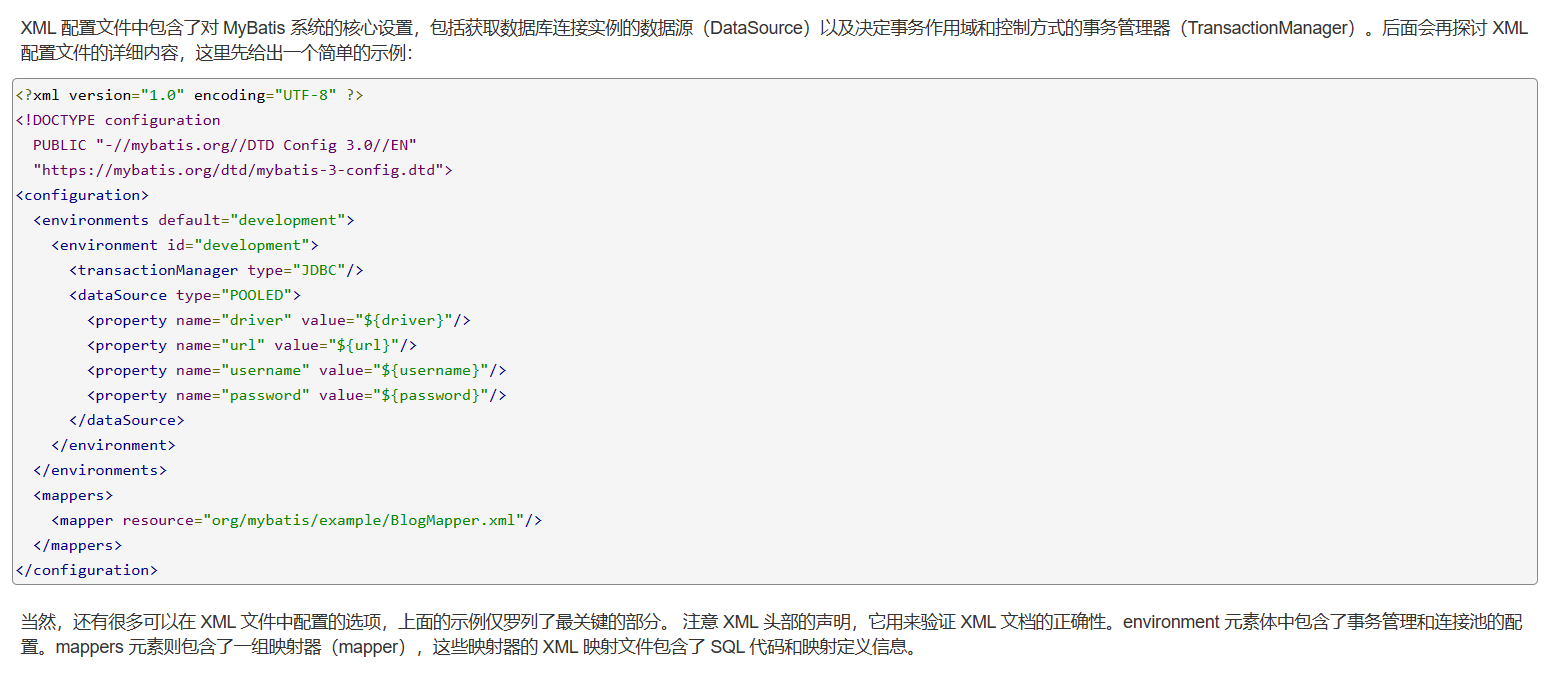
在資料來源<dataSource>的設定中,設定好driver,url,username,password
1 <?xml version="1.0" encoding="UTF-8" ?> 2 <!DOCTYPE configuration 3 PUBLIC "-//mybatis.org//DTD Config 3.0//EN" 4 "https://mybatis.org/dtd/mybatis-3-config.dtd"> 5 <configuration> 6 <environments default="development"> 7 <environment id="development"> 8 <transactionManager type="JDBC"/> 9 <dataSource type="POOLED"> 10 <property name="driver" value="com.mysql.cj.jdbc.Driver"/> 11 <property name="url" value="jdbc:mysql://localhost:3307/mybatis"/> 12 <property name="username" value="root"/> 13 <property name="password" value="root"/> 14 </dataSource> 15 </environment> 16 </environments> 17 <!--<mappers> 18 <mapper resource="org/mybatis/example/BlogMapper.xml"/> 19 </mappers>--> 20 </configuration>
現在需要一個資料庫和表和一些資料用做連線測試
1 CREATE DATABASE IF NOT EXISTS `mybatis` DEFAULT CHARACTER SET utf8mb4 COLLATE utf8mb4_unicode_ci; 2 3 CREATE TABLE USER( 4 `id` INT UNSIGNED PRIMARY KEY AUTO_INCREMENT COMMENT 'ID', 5 `name` VARCHAR(100) COMMENT '姓名', 6 `age` TINYINT UNSIGNED COMMENT '年齡', 7 `gender` TINYINT UNSIGNED COMMENT '性別, 1:男, 2:女', 8 `phone` VARCHAR(11) COMMENT '手機號' 9 ) COMMENT '使用者表'; 10 11 INSERT INTO USER(id, NAME, age, gender, phone) VALUES (NULL,'白眉鷹王',55,'1','18800000000'); 12 INSERT INTO USER(id, NAME, age, gender, phone) VALUES (NULL,'金毛獅王',45,'1','18800000001'); 13 INSERT INTO USER(id, NAME, age, gender, phone) VALUES (NULL,'青翼蝠王',38,'1','18800000002'); 14 INSERT INTO USER(id, NAME, age, gender, phone) VALUES (NULL,'紫衫龍王',42,'2','18800000003'); 15 INSERT INTO USER(id, NAME, age, gender, phone) VALUES (NULL,'光明左使',37,'1','18800000004'); 16 INSERT INTO USER(id, NAME, age, gender, phone) VALUES (NULL,'光明右使',48,'1','18800000005');
構建整體專案結構controller、service、mapper三層架構,建立一個實體類對應資料庫的表結構,建立MyBatis的對映檔案xxxMapper.xml
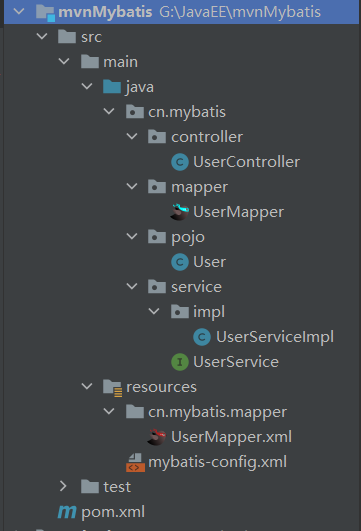
-
-
表所對應的實體類的類名+Mapper.xml
-
例如:表t_user,對映的實體類為User,所對應的對映檔案為UserMapper.xml
-
因此一個對映檔案對應一個實體類,對應一張表的操作
-
MyBatis對映檔案用於編寫SQL,存取以及操作表中的資料
-
在resources檔案目錄下建立mapper的時候需要和main檔案目錄下的mapper同包名,在建立directory的時候,目錄結構不能使用點,而是用/代替

User實體類中的屬性需要和表中的欄位名相對應,這裡也可以用Lombok註解
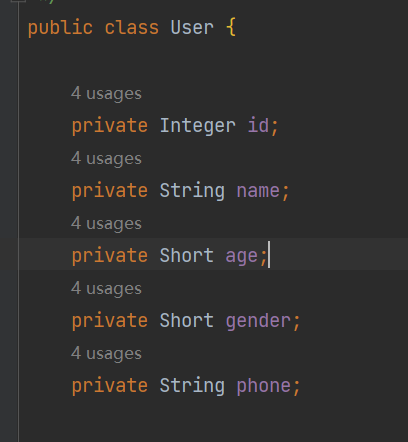
然後在mapper中寫我們需要的語句,查詢語句用<select>、增加語句用<insert>、刪除語句用<delete>、修改語句用<update>標籤,返回型別resultType要和實體類中的實體類名稱對應

1 <?xml version="1.0" encoding="UTF-8" ?> 2 <!DOCTYPE mapper 3 PUBLIC "-//mybatis.org//DTD Mapper 3.0//EN" 4 "https://mybatis.org/dtd/mybatis-3-mapper.dtd"> 5 6 <mapper namespace="mapper.UserMapper"> 7 8 <select id="selectAll" resultType="pojo.User"> 9 SELECT id, name, age, gender, phone FROM user 10 </select> 11 </mapper>
寫好了之後回到mybatis-config.xml中設定一下mapper對映

在UserMapper中將UserMapper.xml中設定好的方法宣告一下,方法名要和上面的id對應上
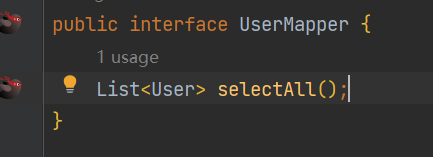
在service層寫好業務邏輯程式碼,在介面中宣告方法,在實現類中實現方法
1 public class UserServiceImpl implements UserService { 2 3 @Override 4 public List<User> selectAll() throws IOException { 5 //讀取MyBatis的核心組態檔 6 InputStream is = Resources.getResourceAsStream("mybatis-config.xml"); 7 //獲取SqlSessionFactoryBuilder物件 8 SqlSessionFactoryBuilder sqlSessionFactoryBuilder = new SqlSessionFactoryBuilder(); 9 //通過核心組態檔所對應的位元組輸入流建立工廠類SqlSessionFactory,生產SqlSession物件 10 SqlSessionFactory sqlSessionFactory = sqlSessionFactoryBuilder.build(is); 11 //獲取sqlSession,此時通過SqlSession物件所操作的sql都必須手動提交或回滾事務 12 SqlSession sqlSession = sqlSessionFactory.openSession(); 13 //通過代理模式建立UserMapper介面的代理實現類物件 14 UserMapper mapper = sqlSession.getMapper(UserMapper.class); 15 //呼叫UserMapper介面中的方法,就可以根據UserMapper的全類名匹配元素檔案,通過呼叫的方法名匹配對映檔案中的SQL標籤,並執行標籤中的SQL語句 16 List<User> users = mapper.selectAll(); 17 return users; 18 } 19 }
在controller層中寫好處理結果程式碼
1 public class UserController { 2 private UserService userService = new UserServiceImpl(); 3 4 public void selectAll() throws IOException { 5 List<User> users = userService.selectAll(); 6 users.forEach(System.out::println); 7 } 8 }
建立一個Test類去測試mybatis資料庫連線,因為沒有引入單元測試依賴,所以這裡用主函數去測試
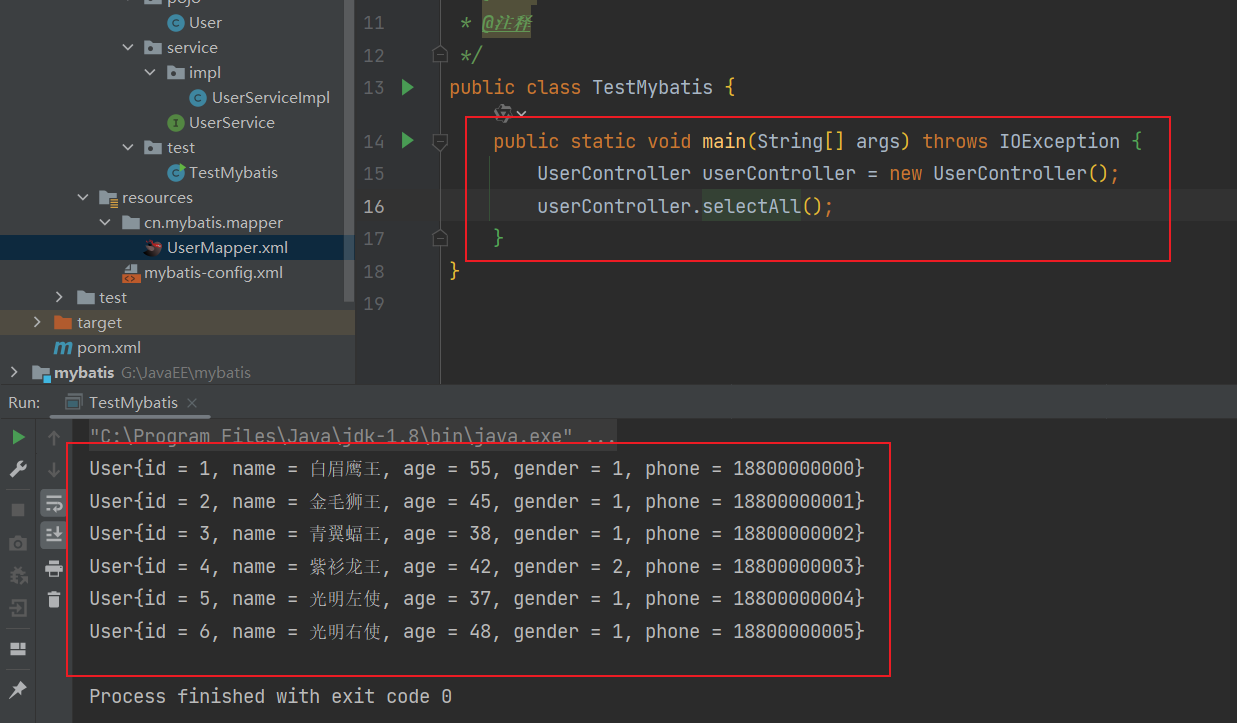
發現結果成功輸出列印
如果SQL語句比較簡單,可以使用mybatis中的註解,查詢語句用@Select、增加語句用@Insert、刪除語句用@Delete、修改語句用@Update註解
在裡面寫上sql語句,再執行發現,也可以查詢成功。

當然,複雜一點的sql語句和動態SQL建議還是使用Mapper設定,只是簡單的sql語句寫在註解裡面可以簡化,複雜的sql只會增加程式碼的複雜度
總結
在Maven專案中,使用mybatis需要先匯入mybatis依賴和連線資料庫的依賴,然後建立mybatis組態檔,在組態檔中設定資料來源細資訊,隨後建立MyBatis的對映檔案Mapper,在mapper檔案中寫好對應的語句,然後在業務層進行SqlSession連線,呼叫mapper中的方法,再在controller層處理返回方法。
2、用Spring框架整合Mybatis
1 <dependencies> 2 <dependency> 3 <groupId>org.mybatis</groupId> 4 <artifactId>mybatis</artifactId> 5 <version>3.5.10</version> 6 </dependency> 7 <dependency> 8 <groupId>mysql</groupId> 9 <artifactId>mysql-connector-java</artifactId> 10 <version>8.0.33</version> 11 </dependency> 12 <dependency> 13 <groupId>org.springframework</groupId> 14 <artifactId>spring-context</artifactId> 15 <version>5.3.30</version> 16 </dependency> 17 <dependency> 18 <groupId>com.alibaba</groupId> 19 <artifactId>druid</artifactId> 20 <version>1.2.20</version> 21 </dependency> 22 <dependency> 23 <groupId>org.mybatis</groupId> 24 <artifactId>mybatis-spring</artifactId> 25 <version>1.3.2</version> 26 </dependency> 27 <dependency> 28 <groupId>org.springframework</groupId> 29 <artifactId>spring-jdbc</artifactId> 30 <version>5.3.2</version> 31 </dependency> 32 </dependencies>
構建整體專案結構
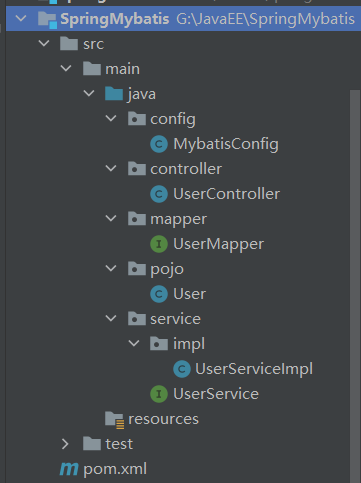
2.1、基於XML整合Mybatis
- 匯入Mybatis整合Spring的相關座標
- 編寫Mapper和Mapper.xml
- 設定SqlSessionFactoryBean和MapperScannerConfigurer
- 編寫測試程式碼
和上面步驟相同,編寫Mapper和Mapper.xml,一定要放在相同路徑下
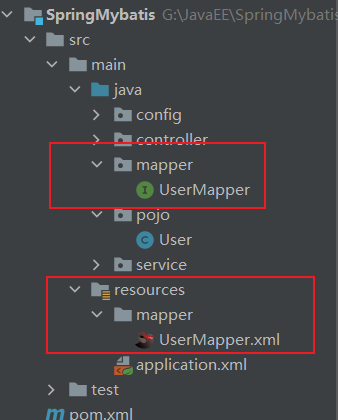
在UserMapper.xml中寫我們需要的語句,並在UserMapper介面中寫對應id的方法宣告;
1 <?xml version="1.0" encoding="UTF-8" ?> 2 <!DOCTYPE mapper 3 PUBLIC "-//mybatis.org//DTD Mapper 3.0//EN" 4 "https://mybatis.org/dtd/mybatis-3-mapper.dtd"> 5 6 <mapper namespace="mapper.UserMapper"> 7 8 <select id="selectAll" resultType="pojo.User"> 9 SELECT id, name, age, gender, phone FROM user 10 </select> 11 </mapper>
public interface UserMapper { List<User> selectAll(); }
同樣的,簡單的SQL語句也可以用@Select註解編寫,不需要UserMapper.xml設定
在Spring組態檔中設定SqlSessionFactoryBean
1 <?xml version="1.0" encoding="UTF-8"?> 2 <beans xmlns="http://www.springframework.org/schema/beans" 3 xmlns:xsi="http://www.w3.org/2001/XMLSchema-instance" 4 xsi:schemaLocation="http://www.springframework.org/schema/beans http://www.springframework.org/schema/beans/spring-beans.xsd"> 5 6 <!--設定SqlSessionFactoryBean,作用將SqlSessionFactory儲存到spring容器--> 7 <bean class="org.mybatis.spring.SqlSessionFactoryBean"> 8 <property name="dataSource" ref="dataSource"></property> 9 </bean> 10 11 <!--設定資料來源資訊--> 12 <bean id="dataSource" class="com.alibaba.druid.pool.DruidDataSource"> 13 <property name="driverClassName" value="com.mysql.cj.jdbc.Driver"></property> 14 <property name="url" value="jdbc:mysql://localhost:3307/mybatis"></property> 15 <property name="username" value="root"></property> 16 <property name="password" value="root"></property> 17 </bean> 18 </beans>
對應的是之前組態檔中的
1 <dataSource type="POOLED"> 2 <property name="driver" value="com.mysql.cj.jdbc.Driver"/> 3 <property name="url" value="jdbc:mysql://localhost:3307/mybatis"/> 4 <property name="username" value="root"/> 5 <property name="password" value="root"/> 6 </dataSource>
在Spring組態檔中設定MapperScannerConfigurer
1 <!--MapperScannerConfigurer,作用掃描指定的包,產生Mapper物件儲存到Spring容器--> 2 <bean class="org.mybatis.spring.mapper.MapperScannerConfigurer"> 3 <property name="basePackage" value="mapper"></property> 4 </bean>
對應的是
1 <mappers> 2 <package name="com.tedu.mapper"/> 3 </mappers>
在Spring組態檔中設定好之後,在使用的時候就不用手動建立了,直接注入即可。
在UserServiceImpl屬性中新增UserMapper,併為其新增setter方法用於注入。
1 public class UserServiceImpl implements UserService { 2 private UserMapper userMapper; 3 4 public void setUserMapper(UserMapper userMapper) { 5 this.userMapper = userMapper; 6 } 7 8 @Override 9 public List<User> selectAll() { 10 return userMapper.selectAll(); 11 } 12 }
同樣,在UserController屬性中新增UserService,併為其新增setter方法用於注入。在selectAll方法中處理返回的結果。
1 public class UserController { 2 private UserService userService; 3 4 public void setUserService(UserService userService) { 5 this.userService = userService; 6 } 7 8 public void selectAll(){ 9 List<User> users = userService.selectAll(); 10 users.forEach(System.out::println); 11 } 12 }
在Spring組態檔中設定上述UserService和UserController用於注入
1 <bean id="userServiceImpl" class="service.impl.UserServiceImpl"> 2 <property name="userMapper" ref="userMapper"></property> 3 </bean> 4 5 <bean id="userContorller" class="controller.UserController"> 6 <property name="userService" ref="userServiceImpl"></property> 7 </bean>
最後建立一個測試類進行資料庫連線測試
1 public class TestSelectAll { 2 public static void main(String[] args) { 3 ApplicationContext context = new ClassPathXmlApplicationContext("application.xml"); 4 UserController userController = context.getBean(UserController.class); 5 userController.selectAll(); 6 } 7 }
可以在控制檯看到列印的結果

總結
基於XML方式整合Mybatis首先需要建立Spring的組態檔,在XML組態檔中去設定bean,將bean物件交由Spring容器管理,其餘的mapper和普通方法一樣。需要設定資料來源DataSource,設定SqlSessionFactoryBean、設定MapperScannerConfigurer,再設定UserMapper、UserService和UserController。在測試類中用ClassPathXmlApplicationContext和getBean獲取到UserContorller物件再呼叫其方法即可。這種方式不用編寫mybatis-config.xml組態檔,在Spring組態檔中全部設定了,雖然簡化了部分操作,但是還是較為繁瑣,下面講一種用註解方式整合mybatis。
2.2、基於註解整合Mybatis
匯入和上述基於XML整合mybatis方法相同的依賴
再構建同樣的專案結構
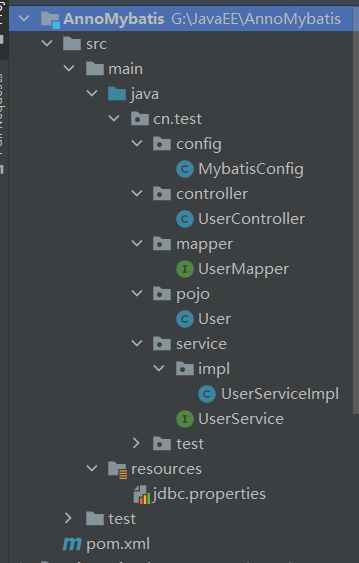
還需要在resources資源目錄下面新增一個組態檔用於存放資料來源設定資訊
jdbc.driver=com.mysql.cj.jdbc.Driver
jdbc.username=root
jdbc.password=root
jdbc.url=jdbc:mysql://localhost:3307/mybatis
除了像上面方法構建的專案結構之外,還需要一個設定類進行設定
1 @Configuration 2 @ComponentScan("cn.test") 3 @PropertySource("classpath:jdbc.properties") 4 @MapperScan("cn.test.mapper") 5 public class MybatisConfig { 6 7 @Bean 8 public DataSource dataSource( 9 @Value("${jdbc.driver}") String driver, 10 @Value("${jdbc.username}") String username, 11 @Value("${jdbc.password}") String passwrod, 12 @Value("${jdbc.url}") String url 13 ){ 14 DruidDataSource dataSource = new DruidDataSource(); 15 dataSource.setDriverClassName(driver); 16 dataSource.setUsername(username); 17 dataSource.setPassword(passwrod); 18 dataSource.setUrl(url); 19 return dataSource; 20 } 21 22 @Bean 23 public SqlSessionFactoryBean sqlSessionFactoryBean(@Autowired DataSource dataSource){ 24 SqlSessionFactoryBean sqlSessionFactoryBean = new SqlSessionFactoryBean(); 25 sqlSessionFactoryBean.setDataSource(dataSource); 26 return sqlSessionFactoryBean; 27 } 28 }
@Configuration註解是宣告該類是一個設定類
@ComponentScan註解是包掃描,掃描該包和該包的子孫包中的類帶有@Component註解的類,交由Spring容器管理
@PropertySource註解是設定資原始檔目錄,classpath後是properties檔案的路徑,載入後可以用${}預留位置獲取properties檔案中的屬性
@MapperScan註解是設定Mapper檔案掃描,相當於mybatis組態檔中<mapper>標籤
組態檔中用@Bean註解設定非自定義Bean的設定,在dataSource方法中傳入連線資料庫四要素並且用@Value註解去注入值,其中用${}預留位置獲取properties檔案中的屬性,最後方法返回dataSource,同樣的用sqlSessionFactoryBean方法sqlSessionFactoryBean,在引數中用@AutoWried注入dataSource引數,其中@AuroWired註解可省略,最後方法返回sqlSessionFactoryBean。
這樣,在Config組態檔中就完成了SqlSessionFactoryBean和MapperScannerConfigurer的設定
接下來就是編寫UserMapper和UserMapper.xml檔案,這裡就不在用XML組態檔進行演示,如需要,上面的其他方法都有演示,這裡就用註解的方式編寫SQL語句。
隨後,編寫三層架構的程式碼,在UserController中,用@AuroWired註解自動注入UserService,並且在類上加上@Controller註解,表示該類是Contriller層類並交由Spring容器管理
1 @Controller 2 public class UserController { 3 @Autowired 4 private UserService userService; 5 6 public void findAll() { 7 List<User> all = userService.findAll(); 8 all.forEach(System.out::println); 9 } 10 }
在UserServiceImpl中用,@AuroWired註解自動注入UserMapper,並且在類上加上@Service註解,表示該類是Service層類並交由Spring容器管理
1 @Service 2 public class UserServiceImpl implements UserService { 3 4 @Autowired 5 private UserMapper userMapper; 6 @Override 7 public List<User> findAll() { 8 return userMapper.findAll(); 9 } 10 }
在UserMapper中,編寫SQL方法,用@Select註解編寫SQL語句,因為在組態檔中加了@MapperScan("cn.test.mapper")註解,所以在此類上不需要加任何Component註解
1 public interface UserMapper { 2 @Select("SELECT id, name, age, gender, phone FROM user") 3 List<User> findAll(); 4 }
最後,編寫測試方法進行資料庫連線測試
1 public class TestAnnoMyBatis { 2 public static void main(String[] args) { 3 ApplicationContext context = new AnnotationConfigApplicationContext(MybatisConfig.class); 4 UserController userController = context.getBean(UserController.class); 5 userController.findAll(); 6 } 7 }
在測試方法中用AnnotationConfigApplicationContext方法載入MybatisConfig組態檔,同樣在控制檯中可以看到成功輸出結果
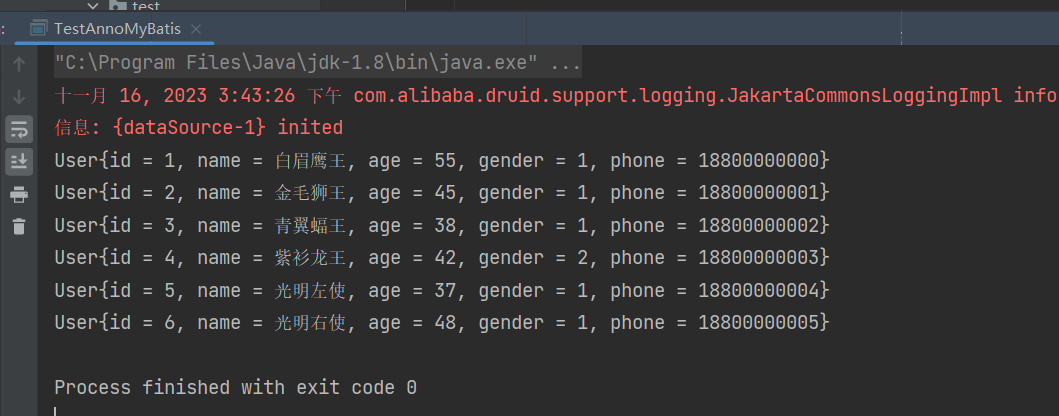
總結
基於註解整合Mybatis方法中,我們不需要設定任何XML檔案,其他操作基本相同,只需要新增一個組態檔,在組態檔中用一些註解和方法去完成設定。同時,在管理Bean時,也是用註解去自動裝配,交由Spring容器去管理。大大簡化了設定。
3、SpringBoot整合Mybatis
用SpringBoot框架整合Mybatis相對就較為簡單了
首先建立於一個SpringBoot專案
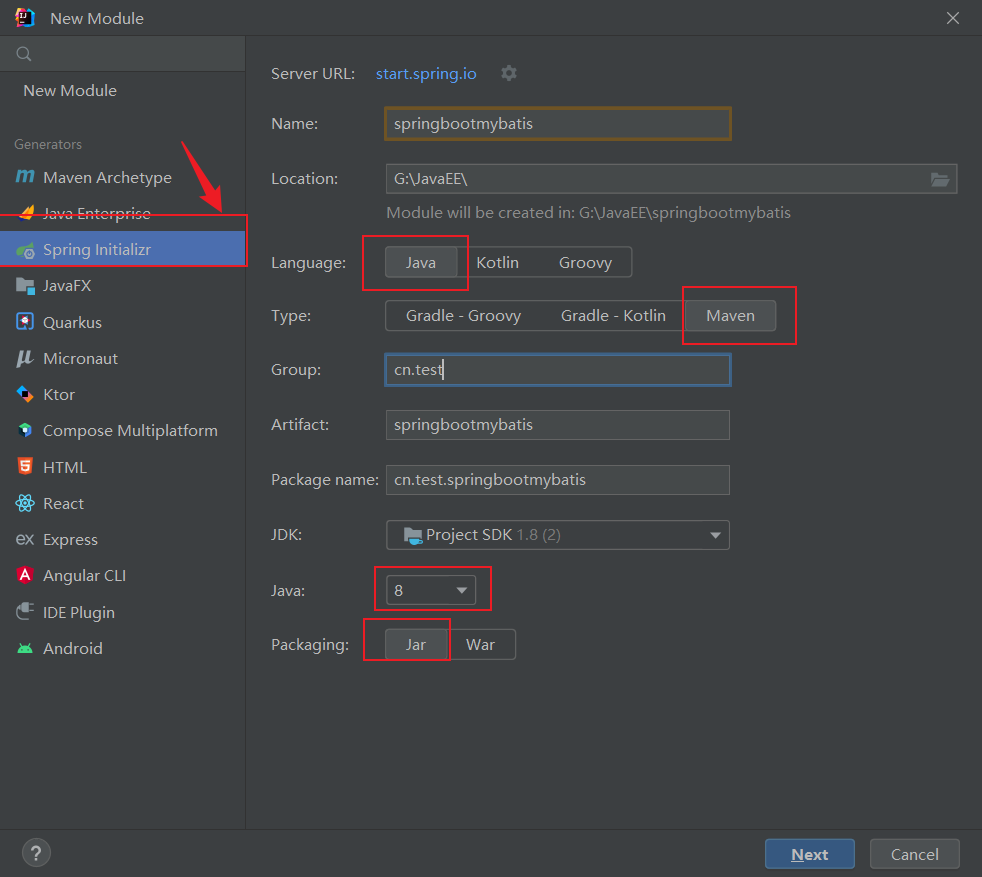
在勾選依賴的時候,需要勾選MyBatisFarmework依賴和MySql依賴進行資料的連線和Mybatis的使用
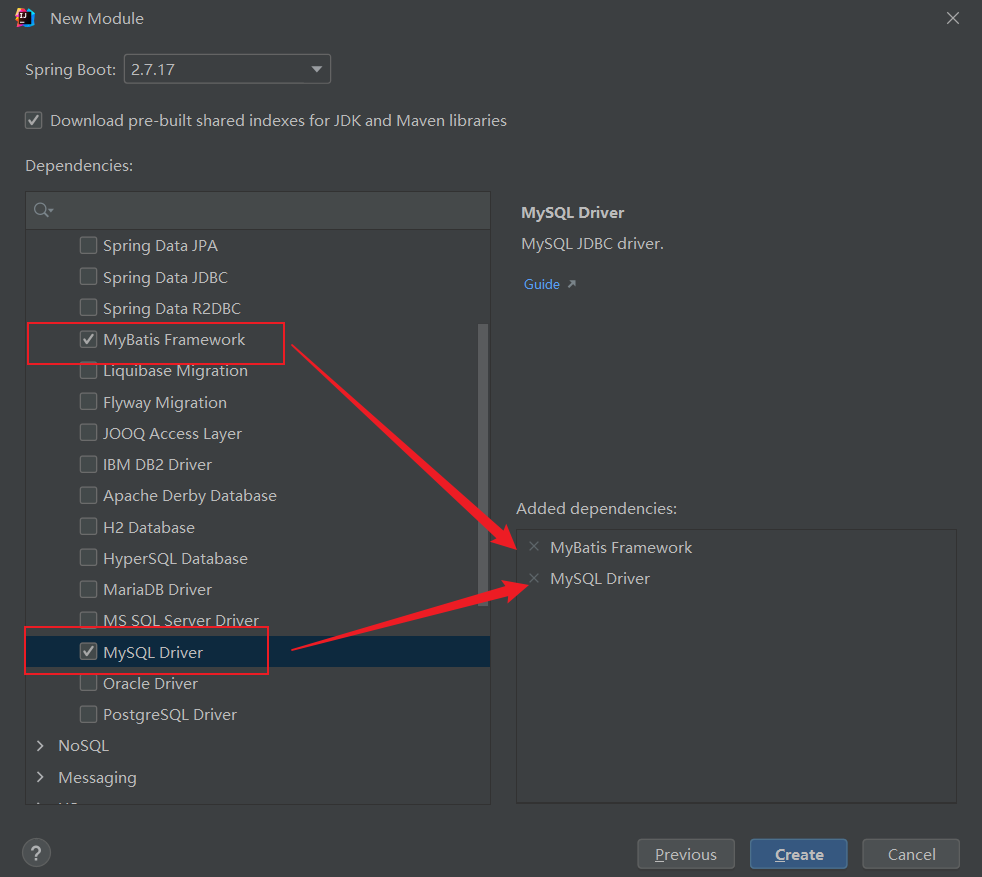
建立完成之後在application.properties組態檔中設定資料來源
spring.datasource.url=jdbc:mysql://localhost:3307/mybatis?serverTimezone=Asia/Shanghai&characterEncoding=utf8 spring.datasource.username=root spring.datasource.password=root spring.datasource.driver-class-name=com.mysql.cj.jdbc.Driver
然後在UserMapper中開始寫SQL語句
1 @Mapper 2 public interface UserMapper { 3 4 @Select("SELECT id, name, age, gender, phone FROM user") 5 List<User> userList(); 6 }
一定要在UserMapper類上加上@Mapper註解,@Mapper註解是識別他為mybatis的mapper介面,會自動的把 加@Mapper 註解的介面生成動態代理類。
同樣的,在UserService中用@AutoWired對UserMapper進行注入,並在該類上加上@Service註解
1 @Service 2 public class UserServiceImpl implements UserService { 3 @Autowired 4 private UserMapper userMapper; 5 6 public List<User> userList(){ 7 return userMapper.userList(); 8 } 9 }
在UserController中用@AutoWired對UserService進行注入並處理返回的結果,並在該類上加上@Controiller註解
1 @Controller 2 public class UserController { 3 @Autowired 4 private UserService userService; 5 6 public void userList(){ 7 List<User> users = userService.userList(); 8 users.forEach(System.out::println); 9 } 10 }
最後在SpringBoot的測試類中寫一個測試方法進行資料庫連線的測試
1 @SpringBootTest 2 class SpringBootMybatisApplicationTests { 3 4 @Autowired 5 private UserController userController; 6 @Test 7 public void test(){ 8 userController.userList(); 9 } 10 11 }
可以看到控制檯成功輸出結果

總結
使用SpringBoot框架整合Mybatis更為簡單,只需要在application.properties組態檔中設定資料來源四要素就行,隨後就可以直接在Mapper中寫SQL語句,最後可以在SpringBootTest類中直接進行測試。